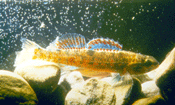Watercress darter: Difference between revisions
m (→History: ah so) |
|||
| Line 5: | Line 5: | ||
== History == | == History == | ||
The watercress darter was discovered in [[1965]] by [[Mike Howell]] and [[R. D. Caldwell]] in [[Glenn Springs]] in Bessemer. In [[1980]], | The watercress darter was discovered in [[1965]] by [[Mike Howell]] and [[R. D. Caldwell]] in [[Glenn Springs]] in Bessemer. In [[1980]], Watercress Darter National Wildlife Refuge was established in Bessemer exclusively to protect the rare fish. | ||
In the 1980s the fish was also discovered in the small stream that runs in front of the [[Hawkins Recreation Center]], and in a [[Roebuck-Hawkins Park#Pond|small pond]] just south of the [[Alabama Department of Youth Services Vacca Campus]]. Darters have also been found in the steam below the dam as it winds through the [[Roebuck Municipal Golf Course]] and flows into [[Village Creek]]. As a result, the [[Birmingham Park and Recreation Board]] agreed to stop using pesticides near the edge of the stream, which increased its fish population, including the watercress darter. | In the 1980s the fish was also discovered in the small stream that runs in front of the [[Hawkins Recreation Center]], and in a [[Roebuck-Hawkins Park#Pond|small pond]] just south of the [[Alabama Department of Youth Services Vacca Campus]]. Darters have also been found in the steam below the dam as it winds through the [[Roebuck Municipal Golf Course]] and flows into [[Village Creek]]. As a result, the [[Birmingham Park and Recreation Board]] agreed to stop using pesticides near the edge of the stream, which increased its fish population, including the watercress darter. | ||
Revision as of 22:22, 23 September 2008
The watercress darter (Etheostoma nuchale) is a small, reddish fish with colorful fins which lives in the Black Warrior River drainage basin near Birmingham. It is currently only known to be found in streams in Powderly, Roebuck Springs, Pinson, and Thomas and Glenn Springs in Bessemer. The largest known female is 2.5 inches in length.
The species can be found in the watercress zone of springs, hence its name. It feeds on snails, crustaceans and insect larvae. The species is endangered and is protected in areas such as the Watercress Darter National Wildlife Refuge and Seven Springs Ecoscape.
History
The watercress darter was discovered in 1965 by Mike Howell and R. D. Caldwell in Glenn Springs in Bessemer. In 1980, Watercress Darter National Wildlife Refuge was established in Bessemer exclusively to protect the rare fish.
In the 1980s the fish was also discovered in the small stream that runs in front of the Hawkins Recreation Center, and in a small pond just south of the Alabama Department of Youth Services Vacca Campus. Darters have also been found in the steam below the dam as it winds through the Roebuck Municipal Golf Course and flows into Village Creek. As a result, the Birmingham Park and Recreation Board agreed to stop using pesticides near the edge of the stream, which increased its fish population, including the watercress darter.
In the early 2000s, the fish was also found in a spring that flows in front of Faith Apostolic Church in Powderly by Samford University professors Mike Howell and Larry Davenport. Seven Springs Ecoscape, a park designed to protect the darter, opened adjacent to the church on April 13, 2008.
In September 2008 the earthen dam at Roebuck-Hawkins Park was demolished by order of the park director, Regina Nummy. She claims to have not known about the pond's importance to the endangered species and to have been responding only to damage caused by flooding of the park's tennis courts, located just above the dam. At least 1,000 individual fish were killed, in part because their instinct when surprised by moving water is to seek shelter in the grasses at the pond's edge rather than to swim with the flow of water. Federal and state wildlife officials collected specimens and began an investigation, which may lead to criminal charges.
References
- Watercress darter. (March 20, 2006). [1] Wikipedia, The Free Encyclopedia. Accessed March 27, 2006.
- "Etheostoma nuchale". FishBase. Ed. Ranier Froese and Daniel Pauly. March 2006 version. N.p.: FishBase, 2006.
- Bryant, Walter. (March 6, 2007). "Birds, watchers flock to Roebuck." The Birmingham News.
- Spencer, Thomas. (April 14, 2008). "Rare fish a symbol of Christian conservation." The Birmingham News.
| Dual licensed with the Creative Commons Attribution Share-Alike License version 3.0 | |
| This article is published under the GFDL and the Creative Commons Attribution Share-Alike license v3.0. | |
